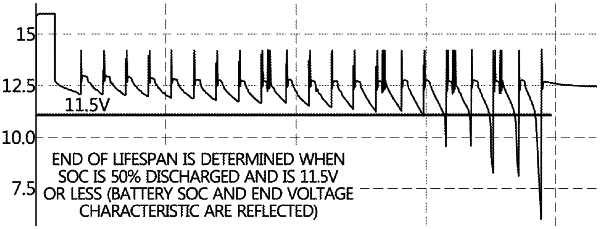| CPC G01R 31/388 (2019.01) [B60L 3/12 (2013.01); B60L 58/10 (2019.02); B60L 58/12 (2019.02); B60L 58/16 (2019.02); G01R 31/367 (2019.01); G01R 31/382 (2019.01); G01R 31/386 (2019.01); G01R 31/392 (2019.01); Y02T 10/70 (2013.01)] | 19 Claims |

|
1. An apparatus for estimating a battery state of charge, the apparatus comprising:
a computer that determines a lifespan of a battery by creating test conditions to simulate a use amount of the battery in engine-on/off states according to an increase in a battery use amount for the battery by reflecting predetermined driving information of a vehicle and then performing the test conditions; and
a tester that performs charging according to predetermined charging conditions and discharging according to predetermined discharging conditions on the battery in accordance with the test conditions to estimate aging of the battery within a preset short time by accelerating durability test of the battery,
wherein the simulation of the use amount of the battery in engine-on state is simulation of an energy use amount when power generation control or actual estimation data of an Idle Start and Go (ISG) system are used, the simulation of an energy use amount in an engine-off state is simulation of an energy use amount when a camera is used, the discharging is performed until the use energy amount becomes half after the engine of the vehicle is stopped, and then the charging is performed and the use energy amount of the battery and end voltage characteristic are reflected.
|